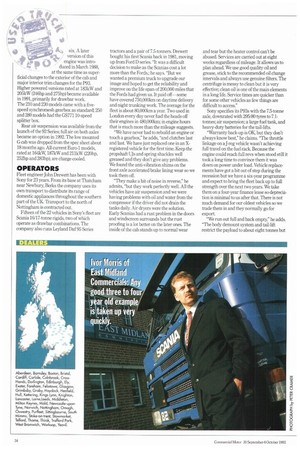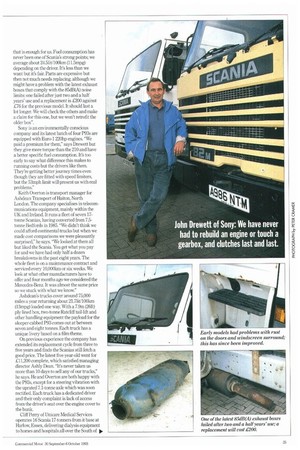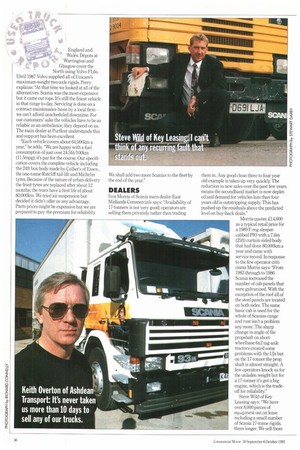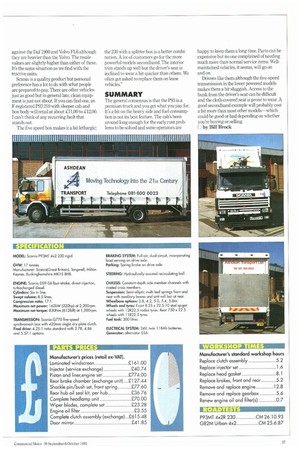\ •& six. A later 4 4r ; version of this
Page 36

Page 37

Page 38

Page 39

If you've noticed an error in this article please click here to report it so we can fix it.
AP to Eh (01) ' engine was intro . WiP duced in IVIarch 1988,
at the same time as superficial changes to the exterior of the cab and major interior trim changes for the P93. Higher powered versions rated at 183kW and 205kW (246hp and 275hp) became available in 1991, primarily for drawbar work. The 210 and 230 models came with a fivespeed synchromesh gearbox as standard; 250 and 280 models had the GS771 10-speed splitter box.
Rear air suspension was available from the launch of the 92 Series; full air on both axles became an option in 1992. The low mounted G cab was dropped from the spec sheet about 18 months ago. All current Euro-1 models, rated at 164kW, 187kW and 211kW (220hp, 252hp and 283hp), are charge-cooled.
Fleet engineer John Drewett has been with Sony for 23 years. From its base at Thatcham near Newbury, Berks the company uses its own transport to distribute its range of domestic appliances throughout the southern part of the UK Transport to the north of Nottingham is contracted out.
Fifteen of the 22 vehicles in Sony's fleet are Scania 16/17-tonne rigids, two of which operate as drawbar combinations. The company also runs Leyland Daf 95 Series tractors and a pair of 7.54onners. Drewett bought his first Scania back in 1981, moving up from Ford D series. "It was a difficult decision to make as the Scanias cost a lot more than the Fords,: he says. "But we wanted a premium truck to upgrade our image and hoped to get the reliability and improve on the life span of 200,000 miles that the Fords had given us. It paid off—some have covered 750,000km on daytime delivery and night trunking work. The average for the fleet is about 80,000km a year. Two used in London every day never had the heads off their engines in 480,00010n; in engine hours that is much more than the mileage suggests.
"We have never had to rebuild an engine or touch a gearbox," he adds, "and clutches last and last. We have just replaced one in an Xregistered vehicle for the first time. Keep the propshaft Lis and spring shackles well greased and they don't give any problems. We found the anti-vibration shims on the front axle accelerated brake lining wear so we took them off.
"They make a bit of noise in reverse," he admits, "but they work perfectly well. All the vehicles have air suspension and we were having problems with oil and water from the compressor if the driver did not drain the tanks daily. Air dryers were the solution. Early Scanias had a rust problem in the doors and windscreen surrounds but the rust proofing is a lot better on the later ones. The inside of the cab stands up to normal wear and tear but the heater control can't be abused. Services are carried out at eight weeks regardless of mileage. It allows us to plan ahead. We use good quality oil and grease, stick to the recommended oil change intervals and always use genuine fitters. The centrifuge is messy to clean but it is very effective; clean oil is one of the main elements in a long life. Service times are quicker than for some other vehicles as few things are difficult to access."
Sony specifies its P93s with the 7.5-tonne axle, downrated with 295/80 tyres to 7.1tonnes; air suspension; a large fuel tank, and heavy-duty batteries for the tail-lifts.
"Warranty back-up is OK, but they don't always know best," he claims. "The throttle linkage on a J-reg vehicle wasn't achieving full travel on the fuel rack. Because the engine could reach full revs when stood still it took a long time to convince them it was down on power under load. Vehicle replacements have got a bit out of step during the recession but we have a six-year programme and expect to bring the fleet back up to full strength over the next two years. We take them on a four-year finance lease so depreciation is minimal to us after that There is not much demand for our oldest vehicles so we trade them in and they normally go for export.
"We run out full and back empty," he adds. "The body demount system and tail-lift restrict the payload to about eight tonnes but
that is enough for us. Fuel consumption has never been one of Scania's strong points; we average about 24.51it/100km (11.5mpg) depending on the driver. It's less than we want but it's fair. Parts are expensive but then not much needs replacing. although we might have a problem with the latest exhaust boxes that comply with the 85dB(A) noise limits: one failed after just two and a half years' use and a replacement is £200 against £76 for the previous model. It should last a lot longer. We will check the others and make a claim for this one, but we won't retrofit the older box".
Sony is an environmentally conscious company and its latest batch of four P93s are equipped with Euro-1 220hp engines. "We paid a premium for them," says Drewett but they give more torque than the 210 and have a better specific fuel consumption. It's too early to say what difference this makes to running costs but the drivers like them. They're getting better journey times even though they are fitted with speed limiters, but the 53mph limit will present us with real problems."
Keith Overton is transport manager for Ashdean Transport of Haiton, North London. The company specialises in telecommunications equipment, mainly within the UK and Ireland. It runs a fleet of seven 17tonne Scanias, having converted from 7.5tonne Bedfords in 1985. "We didn't think we could afford continental trucks but when we made cost comparisons we were pleasantly surprised," he says. "We looked at them all but liked the Scania. You get what you pay for and we have had only half a dozen breakdowns in the past eight years. The whole fleet is on a maintenance contract and serviced every 10,000km or six weeks. We look at what other manufacturers have to offer and four months ago we considered the Mercedes-Benz. It was almost the same price so we stuck with what we know."
Ashdean's trucks cover around 75,000 miles a year returning about 21.71it/100km (13mpg) loaded one way. With a 7.9m (26ft) ply lined box, two-tonne Ratcliff tail-lift and other handling equipment the payload for the sleeper-cabbed P93 comes out at between seven and eight tonnes. Each truck has a unique livery based on a film theme.
On previous experience the company has extended its replacement cycle from three to five years and finds the Scanias still fetch a good price. The latest five-year-old went for £11,200 complete, which satisfied managing director Ashly Dean. "It's never taken us more than 10 days to sell any of our trucks," he says. He and Overton are both happy with the P93s, except for a steering vibration with the uprated 7.1-tonne axle which was soon rectified. Each truck has a dedicated driver and their only complaint is lack of access from the driver's seat over the engine cover to the bunk.
Cliff Perry of Unimre Medical Services operates 16 Scania 17-tonners from it base at Harlow, Essex, delivering dialysis equipment to homes and hospitals all over the South of 01. England and Wales. Depots at Warrington and Glasgow cover the North using Volvo FL6s. Until 1987 Volvo supplied all of Unicare's maximum-weight two-axle rigids. Perry explains: "At that time we looked at all of the alternatives. Scania was the most expensive but it came out tops It's still the finest vehicle in that range to-day. Servicing is done on a contract maintenance basis by a local firm— we can't afford unscheduled downtime. For our customers' sake the vehicles have to be as reliable as an ambulance; they depend on us. The main dealer at Purfleet understands this and support has been excellent.
"Each vehicle covers about 64,0001un a year," he adds. "We are happy with a fuel consumption of just over 24.51it/100krn (11.5mpg); it's par for the course. Our specification covers the complete vehicle including the 24ft box body made by Collier's of Essex , the one-tonne Ratcliff tail-lift and Michelin tyres. Because of the nature of urban delivery the front tyres are replaced after about 12 months; the rears have a first life of about 80,000km. We tried air suspension but decided it didn't offer us any advantage. Parts prices might be expensive but we are prepared to pay the premium for reliability We shall add two more Scanias to the fleet by the end of the year."
Ivor Morris of Scania main dealer East Midlands Commercials says: "Availability of 17-tonners is not very good; operators are selling them privately rather than trading them in. Any good clean three to four year old example is taken up very quickly. The reduction in new sales over the past few years means the secondhand market is now depleted and demand for vehicles lass than four years old is outstripping supply. This has pushed up the residuals above the predicted level on buy-back deals."
Morris quotes £14,000 as a typical retail price for a 1989 F-reg sleepercabbed P93 with a 7.6m (25ft) curtain-sided body that had done 80,000km a year and came with service record. In response to the few operator criticisms Morris says: "From 1983 through to 1986 Scania increased the number of cab panels that were galvanized. With the exception of the roof all of the steel panels are treated on both sides. The same basic cab is used for the whole of Scanias range and rust isn't a problem any more. The sharp change in angle of the propshaft on shortwheelbase 6x2 tag-axle tractors created some problems with the Uis but on the 17-tonner the prop shaft is almost straight. A few operators knock us for the unladen weight but for a 17-tonner it's got a big engine, which is the tradeoff for reliability" Steve Wild of Key Leasing says: "We have over 8,000 pieces of equipment out on lease including a small number of Scania 17-tonne rigids. them longer. We sell them against the Daf 1900 and Volvo FI.6 although they are heavier than the Volvo. The resale values are slightly higher than either of these. It's the same situation as we find with the tractive units.
Scania is a quality product but personal preference has a lot to do with what people are prepared to pay. There are other vehicles just as good but in general late, clean equipment is just not about. If you can find one, an F-registered P93 210 with sleeper cab and box body will retail at about £11,00 to £12,00. I can't think of any recurring fault that stands out.
The five speed box makes it a bit lethargic; the 230 with a splitter box is a better combination. A lot of customers go for the more powerful models secondhand. The interior trim stands up well but the driver's seat is inclined to wear a bit quicker than others. We often get asked to replace them on lease vehicles."
The general consensus is that the P93 is a premium truck and you get what you pay for. It's a bit on the heavy side and fuel consumption is not its best feature. The cab's been around long enough for the early rust problems to be solved and some operators are
happy to keep them a long time. Parts can be expensive but no one complained of needing much more than normal service items. Wellmaintained vehicles, it seems, will go on and on.
Drivers like them although the five-speed transmission in the lower powered models makes them a bit sluggish. Access to the bunk from the driver's seat can be difficult and the cloth-covered seat is prone to wear. A good secondhand example will probably cost a bit more than most other models—which could be good or bad depending on whether you're buying or selling.
by Bill Brock
























































































